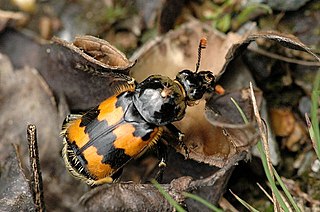
Silphidae is a family of beetles that are known commonly as large carrion beetles, carrion beetles or burying beetles. There are two subfamilies: Silphinae and Nicrophorinae. Members of Nicrophorinae are sometimes known as burying beetles or sexton beetles. The number of species is relatively small, at around two hundred. They are more diverse in the temperate region although a few tropical endemics are known. Both subfamilies feed on decaying organic matter such as dead animals. The subfamilies differ in which uses parental care and which types of carcasses they prefer. Silphidae are considered to be of importance to forensic entomologists because when they are found on a decaying body they are used to help estimate a post-mortem interval.

The Asian long-horned beetle, also known as the starry sky, sky beetle, or ALB, is native to the Korean Peninsula, northern and southern China, and disputably in northern Japan. This species has now been accidentally introduced into the eastern United States, where it was first discovered in 1996, as well as Canada, and several countries in Europe, including Austria, France, Germany, Italy and UK.

The longhorn beetles (Cerambycidae), also known as long-horned or longicorns, are a large family of beetles, with over 35,000 species described.

The huhu beetle is a longhorn beetle endemic to New Zealand. It is the heaviest beetle found in New Zealand.

Dynastes tityus, the eastern Hercules beetle, is a species of rhinoceros beetle native to the Eastern United States. The adult's elytra are green, gray or tan, with black markings, and the whole animal, including the male's horns, may reach 60 mm (2.4 in) in length. The larvae feed on decaying wood from various trees.

Tent caterpillars are moderately sized caterpillars, or moth larvae, belonging to the genus Malacosoma in the family Lasiocampidae. Twenty-six species have been described, six of which occur in North America and the rest in Eurasia. Some species are considered to have subspecies as well. They are often considered pests for their habit of defoliating trees. They are among the most social of all caterpillars and exhibit many noteworthy behaviors.

Adelges tsugae, the hemlock woolly adelgid or HWA, is an insect of the order Hemiptera native to East Asia. It feeds by sucking sap from hemlock and spruce trees. In its native range, HWA is not a serious pest because populations are managed by natural predators and parasitoids and by host resistance. In eastern North America it is a destructive pest that threatens the eastern hemlock and the Carolina hemlock. HWA is also found in western North America, where it has likely been present for thousands of years. In western North America, it primarily attacks western hemlock Tsuga heterophylla and has only caused minor damage due to natural predators and host resistance. Accidentally introduced to North America from Japan, HWA was first found in the eastern United States near Richmond, Virginia, in 1951. The pest is now found from northern Georgia to coastal Maine and southwestern Nova Scotia as well as areas of western Michigan near the eastern Lake Michigan shoreline. As of 2015, HWA has affected 90% of the geographic range of eastern hemlock in North America.

The timberman beetle is a species of woodboring beetle belonging to the longhorn beetle family.
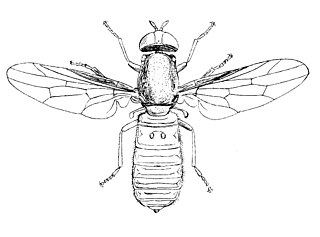
The Scenopinidae or window flies are a small family of flies (Diptera), distributed worldwide. In buildings, they are often taken at windows, hence the common name window flies.
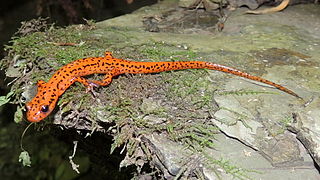
The spotted-tail salamander, also known as a "cave salamander", is a species of brook salamander.

Callipogon relictus is a species of longhorn beetle which is mostly found in Korea, but also in China and southern part of Russian Far East. It inhabits mixed and deciduous forests. The population of Callipogon relictus is decreasing due to deforestation and uncontrolled collection, and therefore the species are listed in the Russian Red Book.

Galerucella calmariensis, sometimes Neogalerucella calmariensis, is a species of leaf beetle in the family Chrysomelidae. It is commonly known as the black-margined loosestrife beetle and is native to Europe and Northern Asia where both adults and larvae feed on purple loosestrife. It has been introduced in North America as a biological control agent for purple loosestrife.

The sirex woodwasp is a species of horntail, native to Europe, Asia, and northern Africa. Adults vary in length from 9 to 36 mm.

Analeptura lineola is a species of beetle in the family Cerambycidae that is found throughout the eastern United States and Canada. It is an anthophilous species, feeding on flower nectar as an adult. In the larval stage, this species bores into the bases of decaying woody plants, including red maple, chestnut, hazelnut, cherry, basswood, viburnum, and laurel.
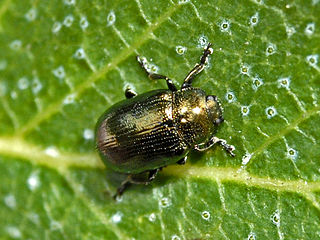
Phratora vitellinae, the brassy leaf beetle, formerly Phyllodecta vitellinae, is a beetle of the family Chrysomelidae found in Europe and Asia. It feeds on Populus and Salix species. The evolution of its host plant preferences and the mechanism by which it uses host plant chemicals to make a larval defensive secretion have been the subject of intense study by research groups in Europe and the Nordic countries.

Phoracantha semipunctata, the Australian Eucalyptus longhorn, is a species of beetle in the family Cerambycidae. Native to Australia, it has now spread to many parts of the world, including practically all countries where tree species of Eucalyptus have been introduced. It has been classified as an invasive pest species of Eucalyptus outside Australia.
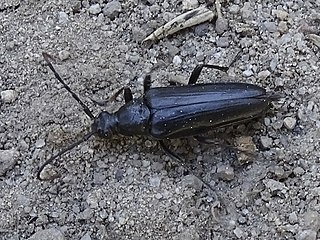
Etorofus anthracinus is a species of beetle in the family Cerambycidae. It was first described by John Lawrence LeConte in 1875. They are found in North America and can be observed seeking the dead parts of living trees for development.
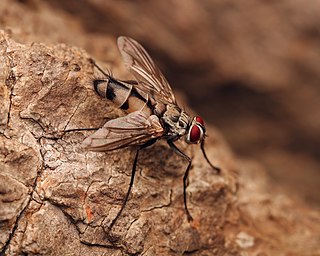
Zelia vertebrata is a species of bristle fly in the family Tachinidae. It is a long-bodied fly with strong abdominal bristles and a distinctive abdominal pattern that resembles vertebrae. It has a widespread North American range, with records stretching from east to west from Washington to Maine, north to south from Québec to Florida. Its larval stage parasitizes beetles. It is most active during the day.

Oemona hirta, the lemon tree borer, also known as the whistling beetle or the singing beetle, is a longhorn beetle endemic to New Zealand. Its larvae are generalist feeders, boring into the wood of a wide variety of trees, native and introduced. When citrus orchards were first established in New Zealand, this beetle started inflicting serious damage, and so gained the name "lemon tree borer". Four species within the genus Oemona have been identified, suggesting that more species could be found. When disturbed by predators or humans, the adult beetle stridulates creating a "rasp" or "squeak" sound by rubbing its thorax and head together against an area of thin ridges. Māori would eat a liquid called "pia manuka", which was produced by manuka trees when its wood was damaged by the larvae. When Captain Cook first arrived in NZ, his naturalists, Banks and Solander, collected a lemon tree borer in their first collection between 1769 and 1771. This oldest collected specimen can be found in the British Museum. A few years after the first collection, the species would be first described by the Danish naturalist Fabricius in 1775.
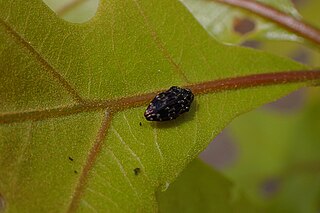
Brachys tesselatus is a species of a leaf-mining beetle, primarily distributed along the southeast coast of the United States. Its distribution corresponds with the turkey oak, its main host plant. Although B. tesselatus primarily feeds and mines on turkey oak leaves, its impact on the host species is limited, allowing for the survival of both species.




















